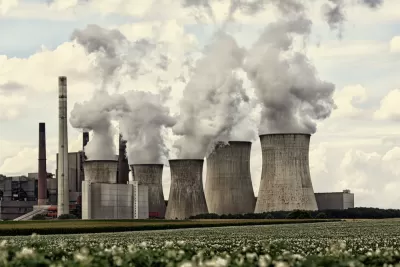Credit EPA emission regulations for the decisions by utilities to close the aging plants. Michigan receives half its power from coal—the most polluting fossil fuel. The new Clean Power Plan rule will cause more remaining plants to close in time.

DTE Energy, which includes "an investor-owned electric utility serving 2.1 million customers in Southeastern Michigan" (per Wikipedia), "expects only 15 coal-fired units to remain in operation after April of 2016," writes Jessica Remer for Power Engineering.
The utility will be looking to make up the lost capacity by purchasing natural gas plants, as are other utilities that are closing coal plants. For the second time this year, natural gas usage in electricity generation exceed coal in July, reports Thomas Overton for Power Magazine.
DTE's decision to shutter their aging plants predates the Clean Power Plan Rule, finalized on August 3, which requires utilities to reduce carbon pollution from existing power plants, though "the utility says the Clean Power Plan will eventually force the shuttering of nearly all of its coal plants," adds Remer.
“There is no piece of control equipment we can put on to meet carbon rules under the Clean Power Plan,” Skiles Boyd, DTE Energy’s vice president of environmental management and resources, tells the Detroit Free Press.
Interestingly, the importance of clean air regulations adopted by the Environmental Protection Agency (EPA) are also shown in DTE's decision not to close the Monroe Power Plant, the one coal power plant it expects to have in operation after 2030. "DTE has invested nearly $2 billion since 2000 on environmental upgrades at the plant," Power Engineering article last year on the plant.
The facility, which is the largest generating plant in Michigan and the fifth-largest in the country, is the first in the state to operate best-in-class systems that reduce nitrogen oxide [NOx] emissions by about 90 percent and sulfur dioxide [SO2] emissions by about 97 percent. Combined, the selective catalytic reduction and flue gas desulfurization systems also eliminate 75- to 90-percent of mercury emissions.
Michigan's largest utility, "Consumers Energy expects to invest about $2 billion to upgrade five of its newer plants, ensuring compliance with emissions regulations, but seven of its older coal-fired plants will have retired by April 2016," writes Remer. "(It) expects to make up some of the lost capacity through the purchase of the former DPC Juniper natural gas plant, while the remaining capacity is replaced by importing power from the regional grid and turning to renewables like wind and solar."
In related news, Wayne Barber, chief analyst for Power Engineering, reports that on Oct. 8, "(t)he Center for Biological Diversity, Center for Environmental Health and Neighbors for Clean Air have sued the Environmental Protection Agency (EPA) for allegedly failing to enforce air quality standards that limit dangerous particulate pollution from coal-fired power plants, cars and other sources in several Western states."
The case is filed as a Clean Air Act citizen suit. It is brought under a provision where citizens can accuse the government of failure to perform a non-discretionary duty required by the Clean Air Act.
Hat tip: Alan Drake, Sierra Club Energy Discussion Group, Beyond Coal Campaign.
FULL STORY: Michigan Retiring 25 Coal-Fired Power Plants by 2020; Utilities Turning to NatGas for Lost Capacity

Planetizen Federal Action Tracker
A weekly monitor of how Trump’s orders and actions are impacting planners and planning in America.

Congressman Proposes Bill to Rename DC Metro “Trump Train”
The Make Autorail Great Again Act would withhold federal funding to the system until the Washington Metropolitan Area Transit Authority (WMATA), rebrands as the Washington Metropolitan Authority for Greater Access (WMAGA).

The Simple Legislative Tool Transforming Vacant Downtowns
In California, Michigan and Georgia, an easy win is bringing dollars — and delight — back to city centers.

The States Losing Rural Delivery Rooms at an Alarming Pace
In some states, as few as 9% of rural hospitals still deliver babies. As a result, rising pre-term births, no adequate pre-term care and "harrowing" close calls are a growing reality.

The Small South Asian Republic Going all in on EVs
Thanks to one simple policy change less than five years ago, 65% of new cars in this Himalayan country are now electric.

DC Backpedals on Bike Lane Protection, Swaps Barriers for Paint
Citing aesthetic concerns, the city is removing the concrete barriers and flexposts that once separated Arizona Avenue cyclists from motor vehicles.
Urban Design for Planners 1: Software Tools
This six-course series explores essential urban design concepts using open source software and equips planners with the tools they need to participate fully in the urban design process.
Planning for Universal Design
Learn the tools for implementing Universal Design in planning regulations.
Smith Gee Studio
City of Charlotte
City of Camden Redevelopment Agency
City of Astoria
Transportation Research & Education Center (TREC) at Portland State University
US High Speed Rail Association
City of Camden Redevelopment Agency
Municipality of Princeton (NJ)


























